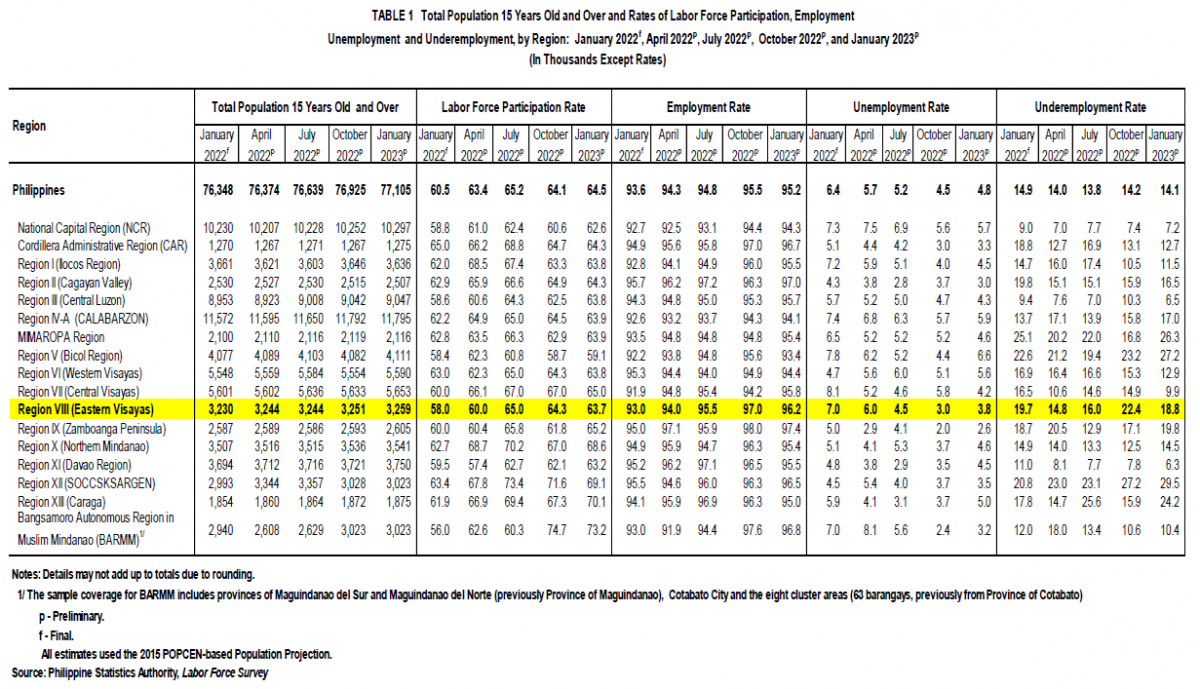Eastern Visayas registered a Labor Force Participation Rate (LFPR) of 63.7 percent in January 2023. This placed the region’s labor force at 2.08 million persons who were either employed or unemployed out of the estimated 3.26 million population 15 years old and over.
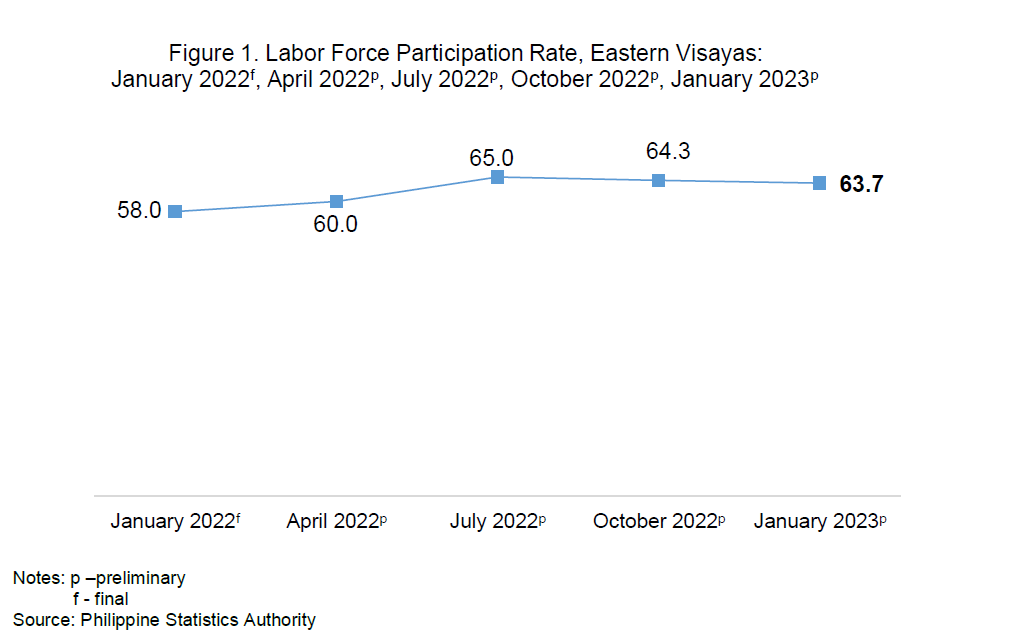
The 63.7 percent LFPR was lower by 0.6 percentage point than the 64.3 percent LFPR recorded in October 2022. However, this figure was higher by 5.7 percentage points compared with the 58.0 LFPR in January 2022. This means that the labor force in January 2023 was lesser by around 15 thousand persons than the 2.09 million persons who were in the labor force in October 2022, but higher by around 203 thousand persons than the 1.87 million labor force in January 2022 (Figure 1).
Eastern Visayas was the fourth region with low LFPR among the 17 regions of the country, even lower by 0.8 percentage point compared with the 64.5 percent national estimate. BARMM had the highest LFPR in January 2023 at 73.2 percent, while Bicol Region had the lowest LFPR at 59.1 percent (Figure 2).
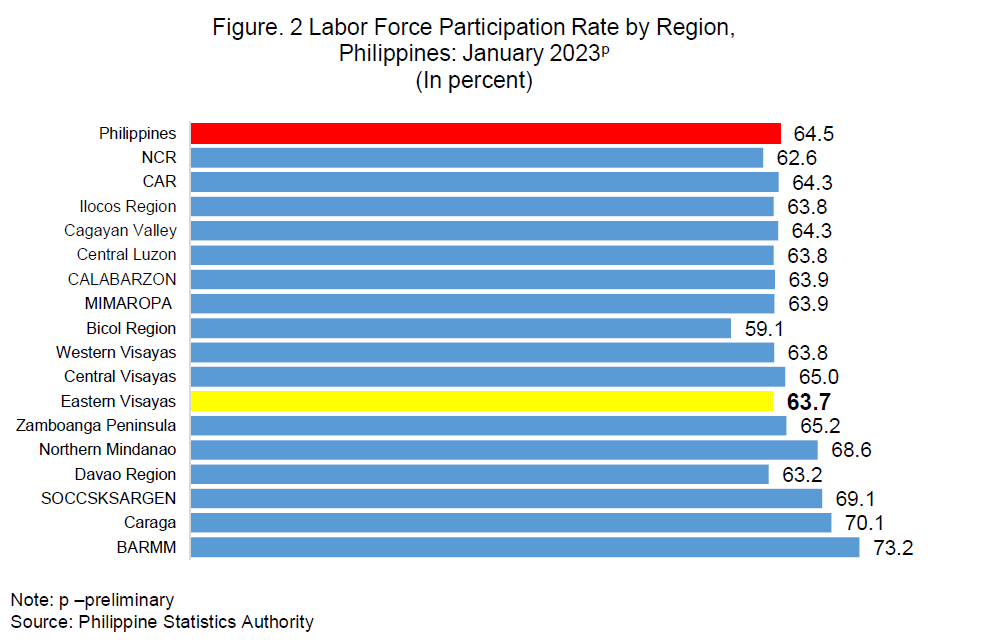
Employment Rate
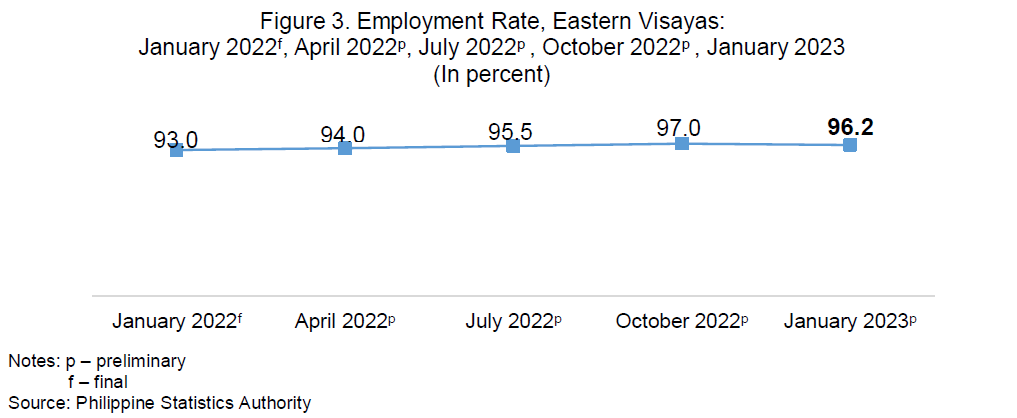
The region’s employment rate in January 2023 decreased to 96.2 percent, from 97.0 percent in October 2022. The 96.2 percent employment rate translates to about 2.00 million employed persons out of the 2.08 million persons in the labor force in January 2023. This number was lower by about 31 thousand employed persons compared with the 2.03 million employed persons reported in October 2022. However, the number of employed persons in January 2023 was higher by around 257 thousand persons than the estimated 1.74 million employed persons in January 2022 (Figure 3).
Eastern Visayas was the sixth among regions with high employment rate in January 2023. It was also among the 12 other regions with employment rates higher than the 95.2 percent national estimate. Zamboanga Peninsula reported the highest employment rate at 97.4 percent, while Bicol Region posted the lowest employment rate at 93.4 percent (Figure 4).
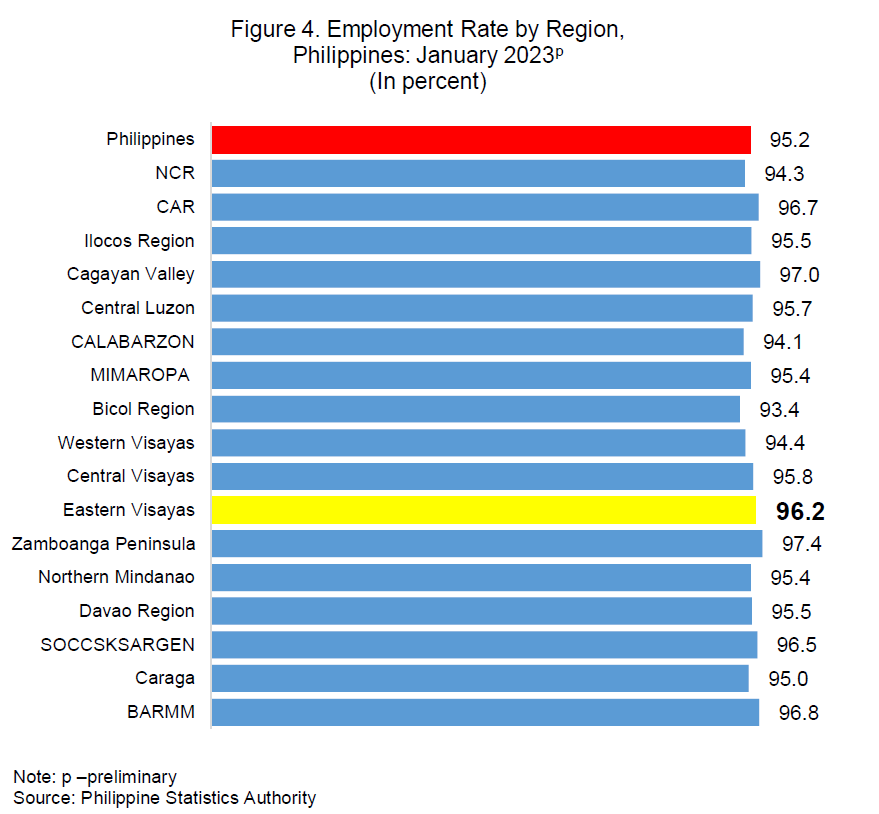
Unemployment Rate
Eastern Visayas’ unemployment rate was estimated at 3.8 percent in January 2023, higher by 0.8 percentage point than the 3.0 percent unemployment rate in October 2022. The 3.8 percent unemployment rate was equivalent to around 79 thousand persons in the labor force who were unemployed in January 2023, higher by about 16 thousand unemployed persons compared with the 63 thousand unemployed persons in October 2022. However, the 3.8 percent unemployment rate in January 2023 was better compared with the 7.0 percent unemployment rate in January 2022 which was equivalent to 132 thousand unemployed persons (Figure 5).
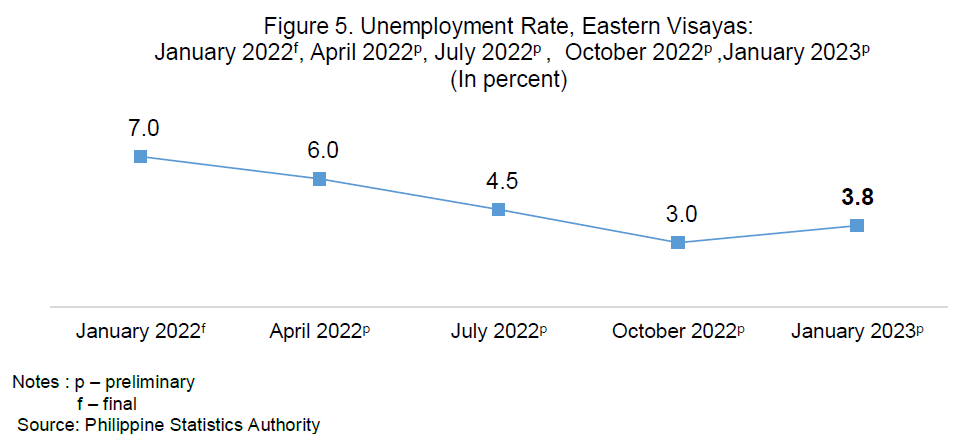
Eastern Visayas was the sixth among regions with low unemployment rate, even lower by 1.0 percentage point than the 4.8 percent national estimate. Meanwhile, Zamboanga Peninsula posted the lowest unemployment rate at 2.6 percent, while Bicol Region recorded the highest unemployment rate at 6.6 percent (Figure 6).
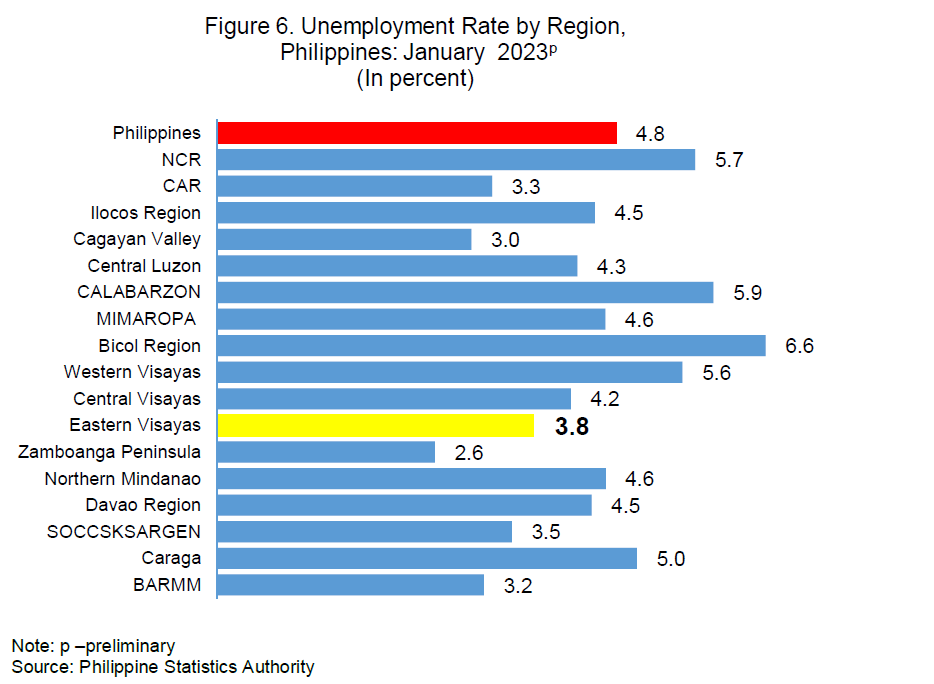
Underemployment Rate
Underemployed persons are employed persons who expressed the desire to have additional hours of work in their present job or to have an additional job, or to have a new job with longer hours of work. The underemployment rate in January 2023 was posted at 18.8 percent or about 375 thousand persons out of around 2.00 million employed persons registered during the month. This was 3.6 percentage points lower than the rate in October 2022 at 22.4 percent. This was also lower by 0.9 percentage point compared with the 19.7 percent underemployment rate registered in January 2022 (Figure 7).
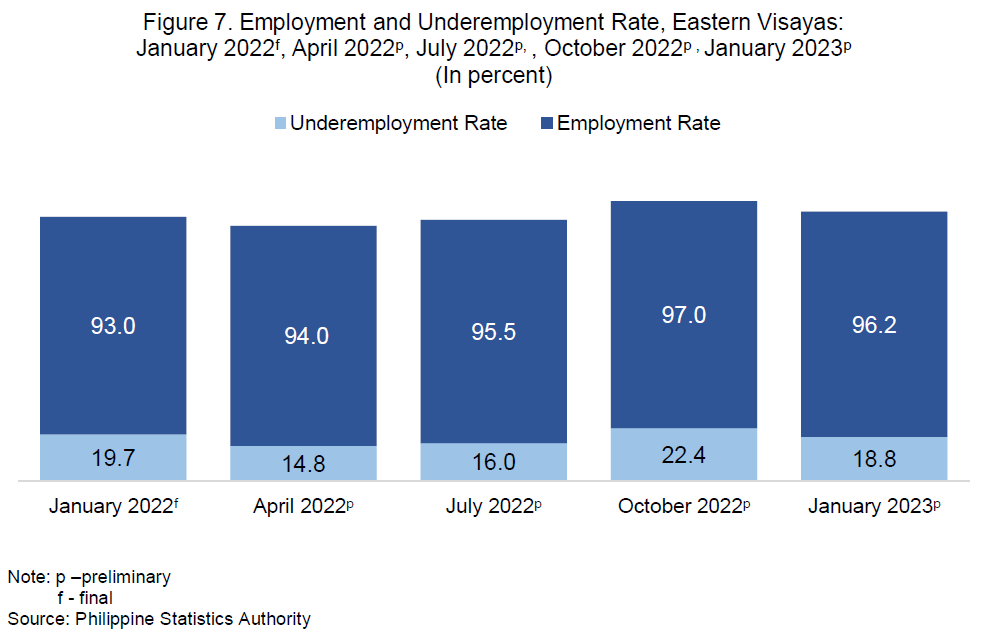
The 18.8 percent underemployment rate of Eastern Visayas in January 2023 was the sixth among regions with high underemployment rate, even higher than the 14.1 percent national estimate. SOCCSKSARGEN recorded the highest underemployment rate at 29.5 percent, while Davao Region recorded the lowest underemployment rate at 6.3 percent.
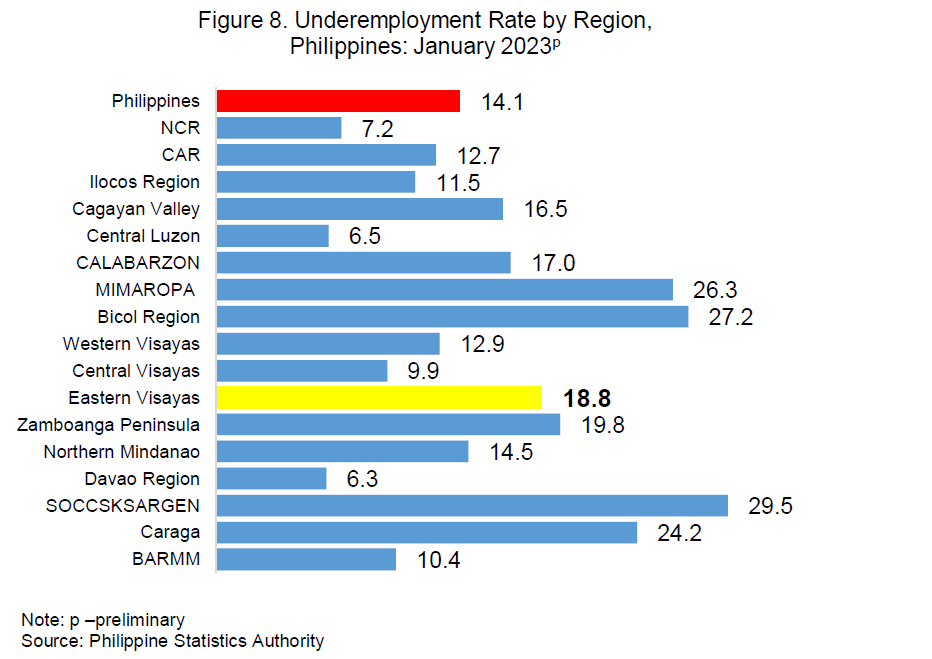
Technical Notes
The stability and growth of a country’s economy hinges on its ability to produce goods and services for both domestic and international use. Labor represents an important factor of production, hence, the improvement of the quality of the labor force, and efforts to make it more productive and responsive to growth are necessary for the development of the economy. A clear knowledge and understanding of the size, composition, and other characteristics of the segment of the population is a big step in this direction. A continuing supply of the data on labor force is indispensable to national and local development planning. The LFS gathers such data on the demographic and socio-economic characteristics of the population with nationwide coverage and conducted on a quarterly and monthly mode by interviewing households.
The LFS aims to provide a quantitative framework for the preparation of plans, and formulation of policies affecting the labor market. The survey is designed to provide statistics on levels and trends of employment, unemployment, and underemployment for the country, as a whole, and for each of the administrative regions.
With regions as domain, survey operations for January 2023 LFS ran for 20 days from 09 to 31 January 2023 and covered 44,302 eligible sample households. The January 2023 LFS adopted the updates on the Philippine Standard Geographic Code to include Bangsamoro Autonomous Region in Muslim Mindanao (BARMM). For comparison with the January 2023 LFS, the estimates for the January 2022 and October 2022 LFS were recomputed to conform with the new configuration of BARMM.
Overseas Filipino Workers are not considered part of the labor force in the Philippines. The sampling frame used was the 2013 Master Sample (MS) refreshed with the results of the 2015 Census of Population (POPCEN 2015). The LFS adopts recent developments in statistical methodology/processes and in the education system.
Enumeration is a highly complex operation, and it may happen that reported/encoded entries during data collection may have some omissions, and implausible/inconsistent entries. During the interview, embedded editing was activated and errors/inconsistent entries were detected by the program. Editing was also done using Computer Aided Field Editing (CAFE) program after every interviewed household to ensure completeness and consistency of encoded entries.
“Population 15 Years Old and Over” refers to the number of population 15 years old and over excluding overseas workers. “In the Labor Force” or “Economically Active Population” refers to persons 15 years old and over who are either employed or unemployed in accordance with the following definitions:
Employed persons include all those who, during the reference period are 15 years old and over as of their last birthday, and are reported either:
a. At work, i.e., those who do any work even for one hour during the reference period for pay or profit, or work without pay on the farm or business enterprise operated by a member of the same household related by blood, marriage, or adoption; or
b. With a job but not at work, i.e., those who have a job or business but are not at work because of temporary illness or injury, vacation, or other reasons. Likewise, persons who expect to report for work or to start operation of a
Page 7 of 8 pages
farm or business enterprise within two weeks from the date of the enumerator’s visit are considered employed.
Underemployed persons include all employed persons who express the desire to have additional hours of work in their present job, or an additional job, or to have a new job with longer working hours. Visibly underemployed persons are those who work for less than 40 hours during the reference period and want additional hours of work.
Unemployed persons include all those who, during the reference period, are 15 years old and over as of their last birthday, and reported as persons:
a. Without work, i.e., had no job or business during the reference period;
b. Currently available for work, i.e., were available and willing to take up work in paid employment or self-employment during the reference period, and/or would be available and willing to take up work in paid employment or self-employment within two weeks after the interview date; and
c. Seeking work, i.e., had taken specific steps to look for a job or establish a business during the reference period, or
d. Not seeking work due to the following reasons: (1) fatigued or believed no work available, i.e., discouraged workers; (2) awaiting results of previous job application; (3) temporary illness or disability; (4) bad weather; and/or (5) waiting for rehire or job recall.
Persons Not in the Labor Force are persons 15 years old and over who are neither employed nor unemployed according to the definitions mentioned. Those not in the labor force are persons who are not looking for work because of reasons such as housekeeping, schooling and permanent disability. Examples are housewives, students, persons with disability, or retired persons.
SGD. WILMA A. PERANTE
Regional Director
